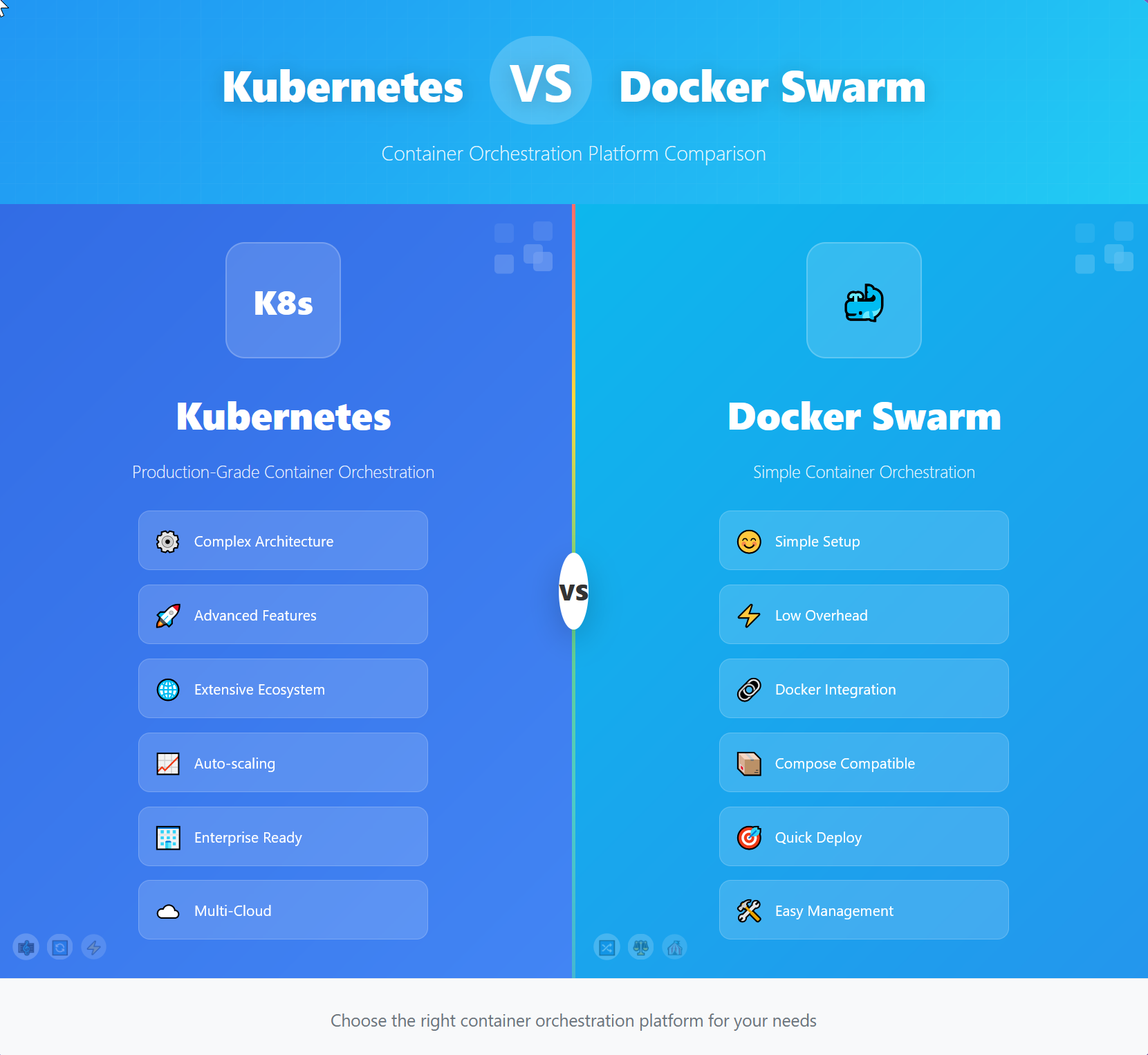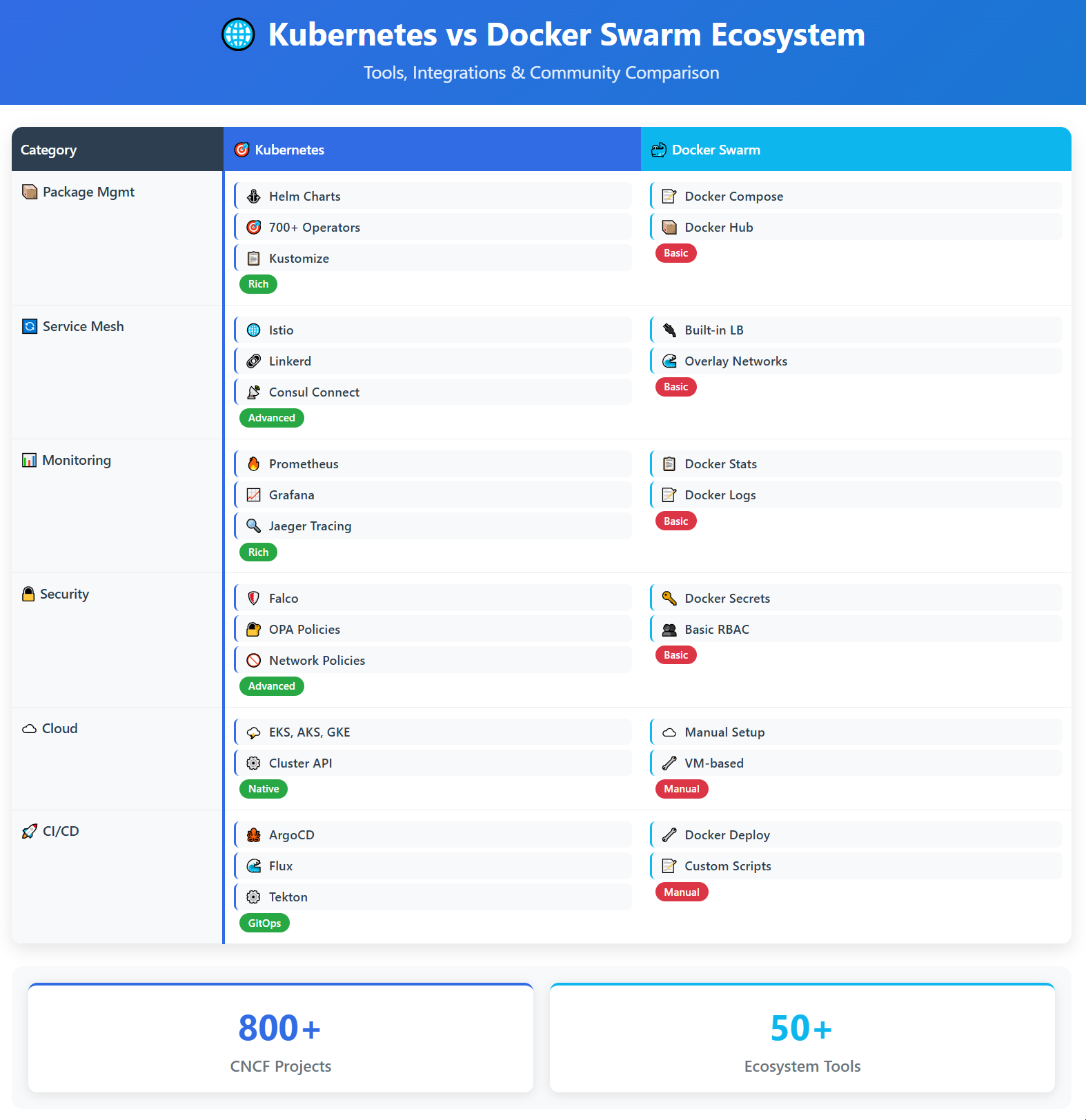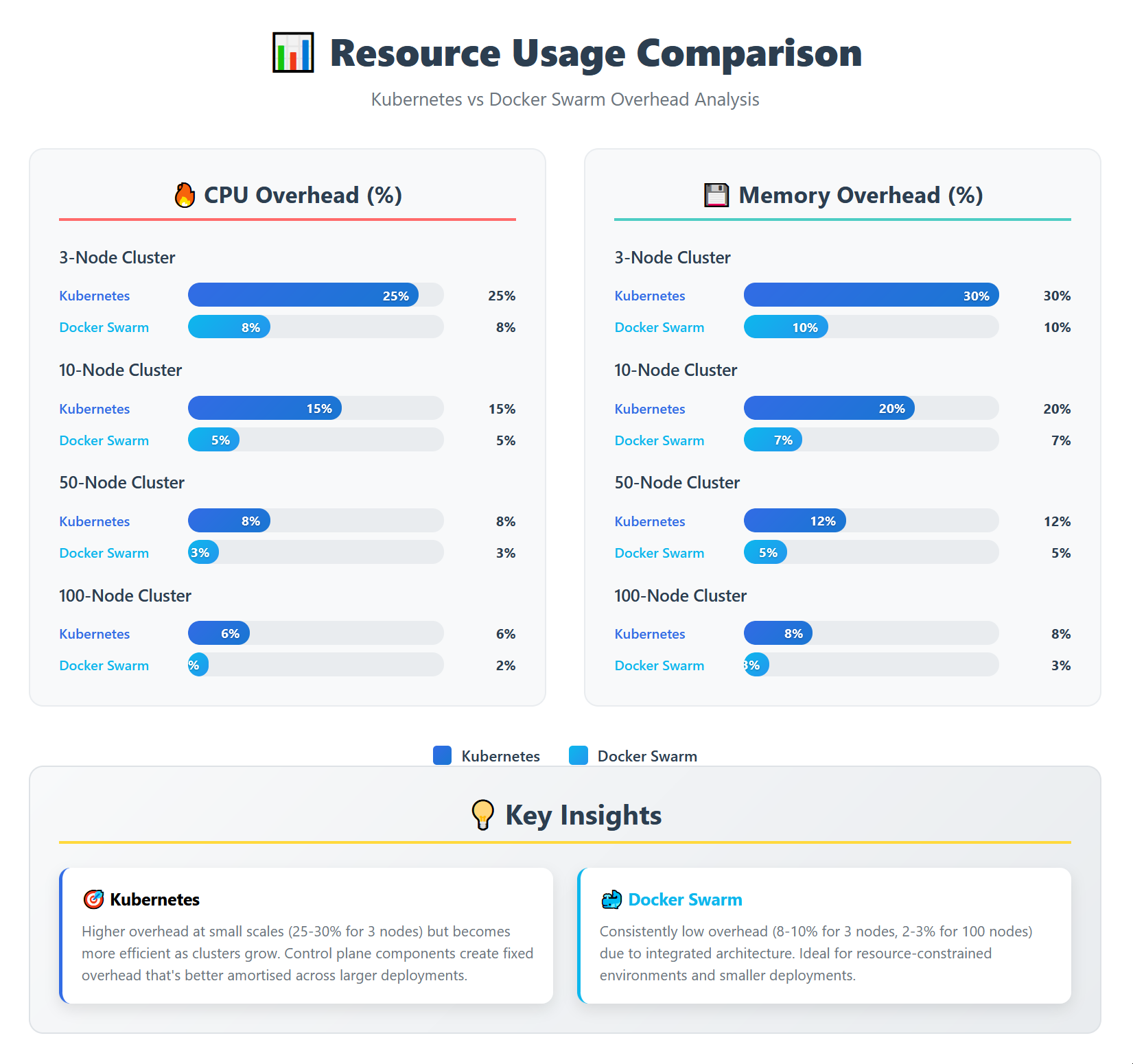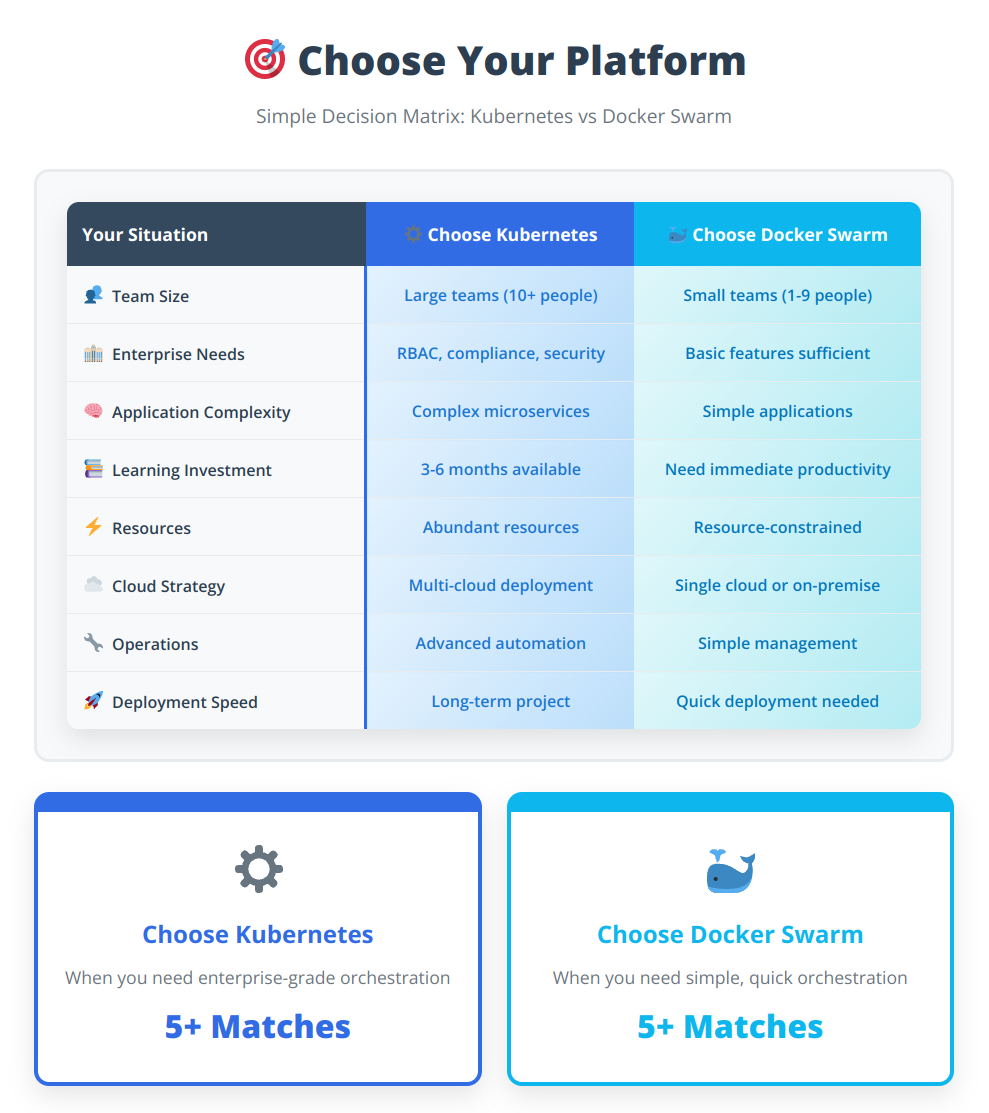Kubernetes vs Docker Swarm: Complete Container Orchestration Guide 2025
Container orchestration has become essential for modern application deployment, with Kubernetes vs Docker Swarm representing the two most significant platforms in this space. While both solutions manage containerised applications at scale, they take fundamentally different approaches to complexity, features, and operational overhead. Understanding the Kubernetes vs Docker Swarm comparison is crucial for making informed infrastructure decisions in 2025.
This comprehensive guide examines every aspect of the Kubernetes vs Docker Swarm debate, from architecture differences to real-world implementation considerations. Whether you’re deploying your first container cluster or evaluating enterprise orchestration platforms, this analysis will help you choose the right solution.
Table of Contents
Understanding Container Orchestration Fundamentals
Container orchestration platforms automate the deployment, scaling, and management of containerised applications. Both solutions in our Kubernetes vs Docker Swarm comparison handle essential tasks like service discovery, load balancing, health monitoring, and rolling updates, but their approaches differ significantly.
The Kubernetes vs Docker Swarm decision often comes down to balancing complexity against capability. Kubernetes offers extensive features and ecosystem support but demands significant learning investment. Docker Swarm provides simplicity and immediate productivity but with more limited advanced capabilities.
Architecture: How Kubernetes vs Docker Swarm Differ
Kubernetes Architecture
Kubernetes employs a master-worker architecture with multiple specialised components. The control plane includes the API server, etcd distributed database, scheduler, and controller manager. Worker nodes run kubelet agents, container runtime, and kube-proxy for networking.
This distributed architecture makes Kubernetes highly resilient and scalable. The declarative approach means you describe desired state, and Kubernetes continuously works to maintain that state. This architecture complexity contributes to Kubernetes’ steep learning curve in the Kubernetes vs Docker Swarm comparison.
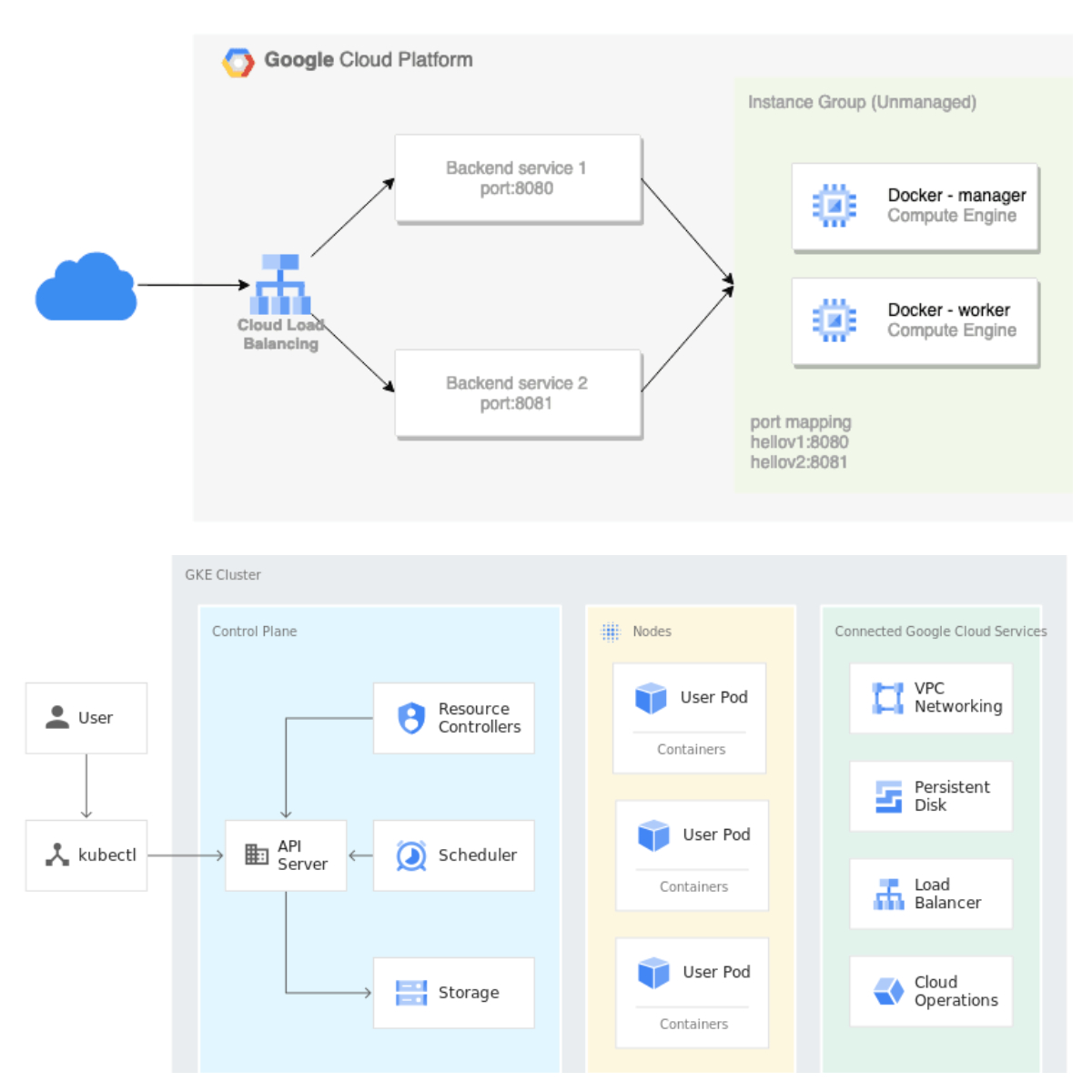
Image Courtesy: GKE cluster architecture https://cloud.google.com/kubernetes-engine/docs/concepts/cluster-architecture
Docker Swarm Architecture
Docker Swarm uses a simpler manager-worker architecture built directly into Docker Engine. Manager nodes handle orchestration and maintain cluster state, while worker nodes execute tasks. The integrated design means fewer moving parts and simpler troubleshooting.
Swarm’s architecture emphasises simplicity over flexibility. Built-in service discovery, load balancing, and rolling updates work out of the box. This architectural simplicity is Docker Swarm’s primary advantage in the Kubernetes vs Docker Swarm evaluation.
Architecture Comparison Table
| Component | Kubernetes | Docker Swarm |
|---|---|---|
| Control Plane | Separate API server, etcd, scheduler, controller manager | Integrated manager nodes |
| Worker Nodes | kubelet, kube-proxy, container runtime | Docker Engine with swarm mode |
| Service Discovery | CoreDNS, service mesh integration | Built-in DNS-based discovery |
| Load Balancing | Ingress controllers, service types | Built-in load balancer |
| State Management | etcd distributed database | Raft consensus in manager nodes |
| Complexity | High – multiple components | Low – integrated architecture |
Feature Comparison: Kubernetes vs Docker Swarm Capabilities
Networking and Service Discovery
Kubernetes provides sophisticated networking through Container Network Interface (CNI) plugins. Multiple networking solutions like Calico, Flannel, and Weave integrate seamlessly. Advanced features include network policies, ingress controllers, and service mesh integration.
Docker Swarm includes built-in overlay networking and service discovery. Services automatically receive DNS names and load balancing. While simpler to configure, Swarm’s networking options are more limited compared to Kubernetes’ extensive ecosystem.
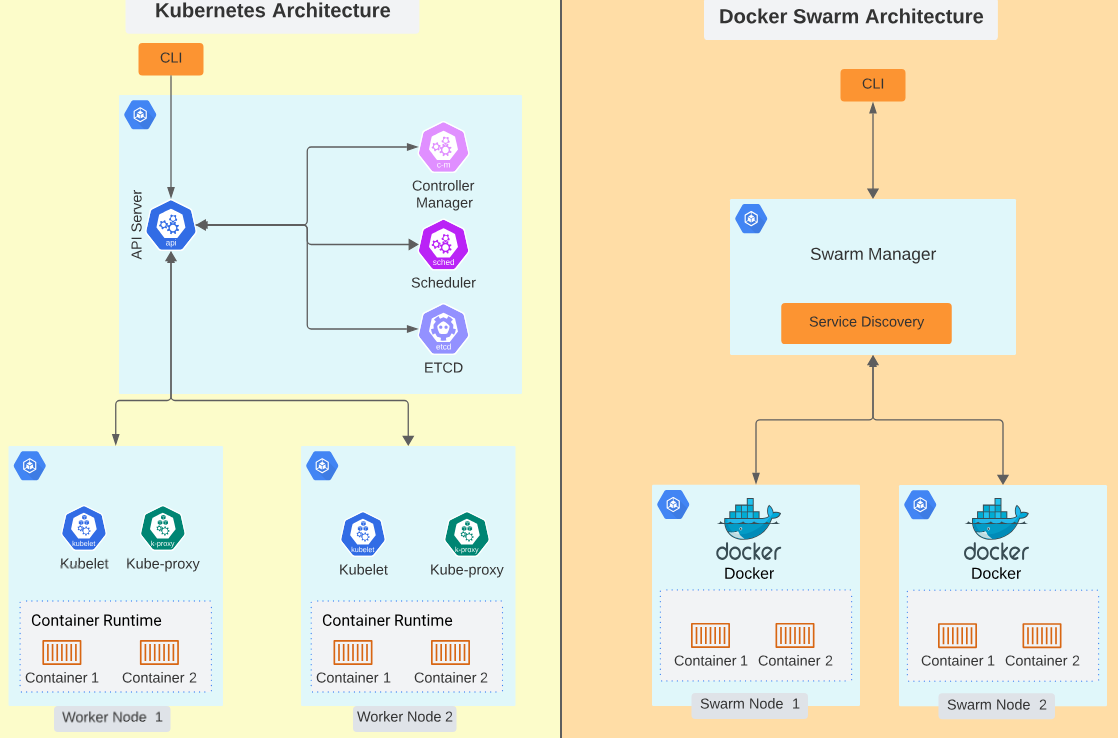
Image Courtesy: Kubernetes vs. Docker Swarm: A Comprehensive Comparison (2023) https://kodekloud.com/blog/kubernetes-vs-docker-swarm/
Storage and Persistent Volumes
The Kubernetes vs Docker Swarm storage comparison heavily favours Kubernetes. Kubernetes supports numerous storage backends through Container Storage Interface (CSI) drivers. Dynamic provisioning, storage classes, and persistent volume claims provide flexible storage management.
Docker Swarm offers basic volume management but lacks dynamic provisioning and storage classes. External storage solutions require manual configuration and management, limiting scalability for stateful applications.
Scaling and Load Management
Kubernetes excels at complex scaling scenarios. Horizontal Pod Autoscaler adjusts replicas based on CPU, memory, or custom metrics. Vertical Pod Autoscaler modifies resource requests automatically. Cluster Autoscaler manages node scaling in cloud environments.
Docker Swarm provides straightforward manual and automatic scaling. Service replicas scale up or down based on declared desired state. While effective for basic scenarios, Swarm lacks Kubernetes’ sophisticated autoscaling capabilities.
Feature Comparison Table
| Feature | Kubernetes | Docker Swarm | Winner |
|---|---|---|---|
| Networking | Advanced CNI plugins, network policies | Built-in overlay networking | Kubernetes |
| Storage | Dynamic provisioning, CSI drivers, storage classes | Basic volume management | Kubernetes |
| Scaling | HPA, VPA, Cluster Autoscaler, custom metrics | Manual and basic automatic scaling | Kubernetes |
| Service Discovery | CoreDNS, service mesh ready | Built-in DNS-based | Tie |
| Load Balancing | Multiple ingress options, service mesh | Built-in round-robin | Kubernetes |
| Configuration | ConfigMaps, Secrets, extensive options | Docker configs and secrets | Kubernetes |
Ecosystem and Community: The Kubernetes vs Docker Swarm Landscape
Kubernetes Ecosystem Advantages
Kubernetes boasts an enormous ecosystem of tools, operators, and integrations. The Cloud Native Computing Foundation (CNCF) hosts hundreds of Kubernetes-related projects. Major cloud providers offer managed Kubernetes services with extensive additional tooling.
Helm charts simplify application packaging and deployment. Operators extend Kubernetes to manage complex stateful applications automatically. Service mesh solutions like Istio provide advanced traffic management and security features.
Docker Swarm Ecosystem Limitations
Docker Swarm’s ecosystem remains significantly smaller in the Kubernetes vs Docker Swarm comparison. While Docker Compose files work with Swarm, the selection of specialised tools and integrations is limited.
Third-party tool support often prioritises Kubernetes over Docker Swarm. Many modern DevOps tools and monitoring solutions offer better Kubernetes integration, potentially limiting long-term tool selection.
Learning Curve and Operational Complexity
Kubernetes Learning Investment
Kubernetes requires substantial learning investment. Understanding pods, services, deployments, ingress, and networking concepts takes considerable time. YAML configuration files can become complex, and debugging requires deep system knowledge.
However, this complexity investment pays dividends at scale. Teams mastering Kubernetes gain access to powerful features and extensive tool ecosystems. The learning curve is steep but leads to sophisticated operational capabilities.
Docker Swarm Simplicity
Docker Swarm’s primary selling point in the Kubernetes vs Docker Swarm debate is simplicity. Teams familiar with Docker can deploy Swarm clusters quickly. Docker Compose file compatibility means existing applications often migrate easily.
Operational overhead remains lower with Docker Swarm. Fewer components mean fewer failure points and simpler troubleshooting. This simplicity advantage makes Docker Swarm attractive for smaller teams or straightforward use cases. For teams managing simpler infrastructures, combining Docker Swarm with effective Linux remote administration tools can create an efficient, manageable container deployment strategy.
Learning Curve Comparison Table
| Aspect | Kubernetes | Docker Swarm |
|---|---|---|
| Initial Setup | Complex – multiple components | Simple – Docker Swarm init |
| Learning Time | 3-6 months for proficiency | 1-2 weeks for basic usage |
| Documentation | Extensive but overwhelming | Concise and focused |
| Debugging | Complex – multiple layers | Straightforward – fewer components |
| YAML Complexity | High – multiple resource types | Low – Docker Compose compatible |
| Team Training | Significant investment required | Minimal for Docker-familiar teams |
Performance and Resource Usage
Kubernetes Resource Overhead
Kubernetes clusters require significant resources for control plane components. etcd, API server, scheduler, and controller manager consume CPU and memory continuously. Worker node agents add additional overhead per node.
This overhead becomes negligible at scale but impacts small deployments. Three-node Kubernetes clusters might dedicate 20-30% of resources to orchestration overhead, affecting the Kubernetes vs Docker Swarm cost comparison for small deployments.
Docker Swarm Efficiency
Docker Swarm maintains lower resource overhead due to its integrated architecture. Manager nodes handle orchestration without separate control plane services. Worker nodes require minimal additional resources beyond container runtime.
For small to medium deployments, Docker Swarm’s efficiency advantage is significant. The same hardware can support more application containers with Swarm compared to Kubernetes, improving resource utilisation.
Enterprise Features and Compliance
Kubernetes Enterprise Readiness
Kubernetes offers extensive enterprise features. Role-based access control (RBAC) provides granular security controls. Network policies enable microsegmentation. Pod Security Standards enforce security constraints.
Compliance frameworks increasingly recognise Kubernetes. Major vendors offer enterprise Kubernetes distributions with additional security, monitoring, and support features. The platform’s maturity makes it suitable for regulated industries.
Docker Swarm Enterprise Limitations
Docker Swarm’s enterprise feature set is more limited in the Kubernetes vs Docker Swarm comparison. Basic RBAC exists, but advanced security features lag behind Kubernetes. Compliance tooling and enterprise integrations are less mature.
Mirantis Kubernetes Engine (formerly Docker Enterprise) provided additional enterprise features, but the ecosystem remains smaller than Kubernetes’. Organisations requiring extensive compliance features often find Kubernetes better supported.
Multi-Cloud and Hybrid Deployment
Kubernetes Multi-Cloud Advantages
Kubernetes excels at multi-cloud and hybrid deployments. Major cloud providers offer managed Kubernetes services with consistent APIs. Tools like Cluster API enable declarative cluster management across providers.
Federation and multi-cluster management tools allow spanning workloads across regions and clouds. This portability advantage is significant in the Kubernetes vs Docker Swarm evaluation for enterprise deployments.
Docker Swarm Portability Limitations
Docker Swarm works across clouds but lacks sophisticated multi-cluster management tools. Cross-cloud networking and service discovery require manual configuration. Cloud-specific integrations are less mature than Kubernetes equivalents.
While Docker containers remain portable, Swarm orchestration features don’t span clouds as seamlessly as Kubernetes. This limitation affects the Kubernetes vs Docker Swarm decision for multi-cloud strategies.
Cloud Provider Support Table
| Cloud Provider | Kubernetes Service | Docker Swarm Support | Kubernetes Advantage |
|---|---|---|---|
| AWS | EKS | Manual setup only | Managed service, extensive integrations |
| Google Cloud | GKE | Manual setup only | Native Kubernetes, autopilot mode |
| Microsoft Azure | AKS | Manual setup only | Managed service, Azure integrations |
| IBM Cloud | IKS | Limited support | Enterprise features, hybrid cloud |
| Oracle Cloud | OKE | Basic support | Managed service, always-free tier |
Use Case Recommendations: When to Choose Each Platform
Choose Kubernetes When
Kubernetes suits complex, scalable applications requiring advanced features. Large development teams benefit from Kubernetes’ extensive capabilities and ecosystem. Multi-cloud deployments leverage Kubernetes’ portability advantages.
Enterprise environments needing compliance, security features, and vendor support find Kubernetes well-suited. Applications requiring sophisticated networking, storage, or scaling benefit from Kubernetes’ advanced features.
Choose Docker Swarm When
Docker Swarm excels for simpler applications with straightforward requirements. Small teams wanting quick deployment without extensive learning investment prefer Swarm’s simplicity. Development and testing environments benefit from minimal overhead.
Legacy applications migrating from Docker Compose often transition smoothly to Docker Swarm. Resource-constrained environments appreciate Swarm’s efficiency. Teams prioritising operational simplicity over advanced features find Swarm appealing.
Use Case Decision Matrix
| Use Case | Kubernetes | Docker Swarm | Recommendation |
|---|---|---|---|
| Enterprise Production | ✅ Excellent | ⚠️ Limited | Kubernetes |
| Small Team Projects | ⚠️ Overkill | ✅ Perfect | Docker Swarm |
| Multi-Cloud Deployment | ✅ Excellent | ❌ Poor | Kubernetes |
| Development Environment | ⚠️ Complex | ✅ Simple | Docker Swarm |
| Microservices Architecture | ✅ Excellent | ⚠️ Basic | Kubernetes |
| Legacy Application Migration | ⚠️ Complex | ✅ Easy | Docker Swarm |
| Compliance Requirements | ✅ Excellent | ❌ Limited | Kubernetes |
| Resource-Constrained Environment | ❌ High overhead | ✅ Efficient | Docker Swarm |
Migration Considerations in the Kubernetes vs Docker Swarm Decision
Migrating from Docker Swarm to Kubernetes
Teams outgrowing Docker Swarm’s capabilities often migrate to Kubernetes. The transition requires significant re-architecting and team training. Applications need restructuring to leverage Kubernetes features effectively.
Migration tools like Kompose help convert Docker Compose files to Kubernetes manifests, but expect substantial effort. Planning migration paths early helps avoid costly re-architecture later. Consider managed Kubernetes services to reduce operational complexity.
Migrating from Kubernetes to Docker Swarm
Kubernetes to Docker Swarm migration is less common but possible. Reasons include reducing operational complexity or resource overhead. Applications must simplify to match Swarm’s more limited feature set.
This migration path typically involves accepting reduced functionality for operational simplicity. Careful evaluation ensures critical features remain available after migration.
Industry Trends and Future Outlook
Kubernetes Market Dominance
Kubernetes has achieved clear market leadership in the Kubernetes vs Docker Swarm competition. Major cloud providers invest heavily in managed Kubernetes services. Enterprise adoption continues accelerating across industries.
The CNCF ecosystem’s growth reinforces Kubernetes’ position. New tools and standards increasingly assume Kubernetes as the deployment target. This momentum creates network effects favouring continued Kubernetes adoption.
Docker Swarm’s Niche Position
Docker Swarm maintains relevance for specific use cases emphasising simplicity. Development environments, edge deployments, and small-scale applications benefit from Swarm’s minimal overhead.
Docker’s focus has shifted toward development tools and Docker Desktop. While Swarm receives maintenance updates, major feature development has slowed compared to Kubernetes’ rapid evolution.
Making the Kubernetes vs Docker Swarm Decision
The Kubernetes vs Docker Swarm choice depends on balancing capability requirements against operational complexity. Kubernetes offers extensive features and ecosystem support but demands significant learning investment. Docker Swarm provides immediate productivity and operational simplicity but with limited advanced capabilities.
Consider team expertise, application requirements, and long-term growth plans. Kubernetes suits teams ready to invest in learning for advanced capabilities. Docker Swarm serves teams wanting simple, immediate container orchestration.
Most organisations trending toward Kubernetes as default choice, using Docker Swarm for specific simple use cases. The container orchestration landscape increasingly assumes Kubernetes knowledge, making it the safer long-term investment for most teams.
Start with Docker Swarm for simple requirements and immediate needs, but plan Kubernetes adoption as applications and teams grow. The Kubernetes vs Docker Swarm decision isn’t permanent, but migration effort favours making the right initial choice.
Final Recommendations Summary
| Scenario | Recommended Platform | Key Reasons |
|---|---|---|
| Enterprise Production | Kubernetes | Advanced features, ecosystem, compliance |
| Small Development Team | Docker Swarm | Simplicity, quick setup, low overhead |
| Learning Container Orchestration | Docker Swarm → Kubernetes | Start simple, migrate when ready |
| Multi-Cloud Strategy | Kubernetes | Better portability and cloud integration |
| Resource-Constrained Environment | Docker Swarm | Lower overhead, efficient resource usage |
| Complex Microservices | Kubernetes | Advanced networking, service mesh, scaling |
| Quick Prototyping | Docker Swarm | Faster setup, Docker Compose compatibility |
| Long-term Investment | Kubernetes | Market momentum, ecosystem growth |
The container orchestration landscape continues evolving, but the Kubernetes vs Docker Swarm comparison clearly shows each platform’s strengths. Choose based on your current needs while considering future growth and complexity requirements.


